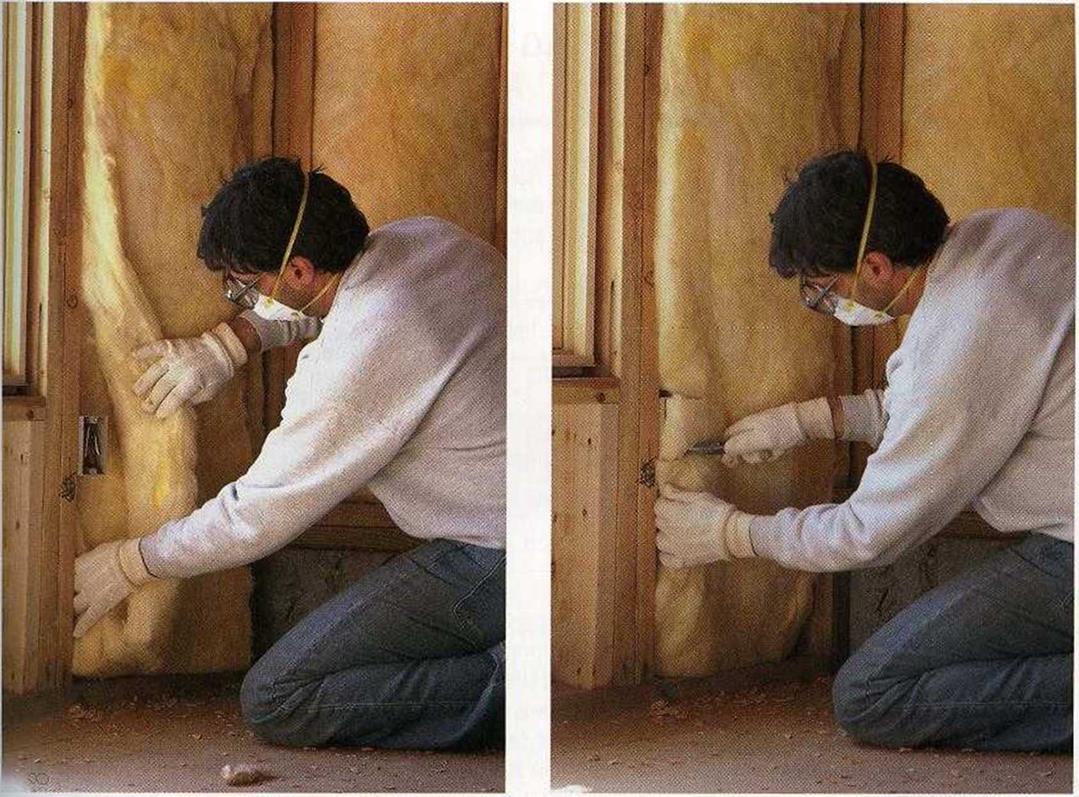Insulating between floor joists in crawl spaces
Floor insulation is important in a house with a crawl-space foundation. Often, it is not enough just to put insulation under the floor, because cold can pass through the rim joist. Unless batts fill the entire joist space, cold air can seep in through the rim joist and over the top of the batts, making the floor uncomfortably chilly.
To prevent this from happening, you can either hold the insulation high or roll it up to cover the rim joist (see the top illustration on p. 206). Better yet, use a thicker batt with a higher R-value to fill the entire joist space and butt up against the rim joist.
When insulating between I-joists, make sure the insulation is wide enough to extend all the way from web to web. If you live in a cold part of the country and yoifre using kraft paper-faced insulation, the paper should face toward the floor. This may seem back-
 INSULATE AROUND ELECTRICAL BOXES. First, divide the batt into two layers instead of compressing it. Slide the back layer behind the outlet box (see the photo far left), then cut out the front layer to fit around the box (see the photo near left). This technique also works for installing fiberglass batts around electrical wires and plumbing pipes.
INSULATE AROUND ELECTRICAL BOXES. First, divide the batt into two layers instead of compressing it. Slide the back layer behind the outlet box (see the photo far left), then cut out the front layer to fit around the box (see the photo near left). This technique also works for installing fiberglass batts around electrical wires and plumbing pipes.
[Photo by Steve Culpepper, courtesy Fine Homebuilding magazine, – The Taunton Press, Inc.]


ward, but the paper acts as a vapor barrier (more on that later) and must face the heat, so to speak. If you live in an area where cooling (air-conditioning) is an issue for a majority of the year, staple the kraft paper to the underside of the joists.
It can be a pain to install batts of insulation under a floor, because there is often not much space between the ground and the joists. Its not a lot of fun to lie on your back and install fiberglass batts! Sometimes, especially in dry dimates, it’s possible to insulate the floor before you sheathe. The drawback with this technique is that subcontractors (plumbing and heating, especially) may not treat your work with TLC. In rainy Oregon, we wait to insulate until after the shingles are on and the house is closed in. Either way, take your time, and make sure that underfloor insulation batts are installed properly and securely around all pipes and conduits.
There are a number of ways to hold underfloor batts in place (see the bottom illustration on p. 206). In Oregon, its common to nail strips of lath every 12 in. to 16 in. o. c. across the bottom of the joists once the insulation is installed. Its a lot of work, but it holds the batts securely without compressing them. Another way is to staple polypropylene (not cotton) twine or mesh to the bottom edges of the joists. I’ve also seen people staple chicken wire or hardware cloth across the joists. Still another option is to use wire supports designed specifically for the job. Called lightning rods or tiger teeth, these wire supports clip between joists and bow up against the batts, holding them in place. Installed about every 12 in. or so, they do a good job of keeping the batts in place for years to come. Just take care not to compress the batts when installing the rods.






Leave a reply